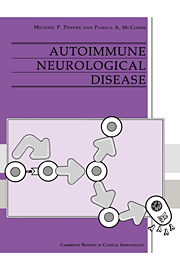Book contents
- Frontmatter
- Contents
- Preface
- 1 Antigen recognition and self–non-self discrimination
- 2 An introduction to neuroimmunology
- 3 Experimental autoimmune encephalomyelitis
- 4 Multiple sclerosis
- 5 Acute disseminated encephalomyelitis
- 6 The stiff-man syndrome
- 7 Experimental autoimmune neuritis
- 8 The Guillain–Barré syndrome and acute dysautonomia
- 9 Chronic immune-mediated neuropathies
- 10 Autoimmune diseases of the neuromuscular junction and other disorders of the motor unit
- 11 Inflammatory myopathies and experimental autoimmune myositis
- 12 Paraneoplastic neurological disorders
- 13 Neurological complications of connective tissue diseases and vasculitis
- Index
1 - Antigen recognition and self–non-self discrimination
Published online by Cambridge University Press: 22 September 2009
- Frontmatter
- Contents
- Preface
- 1 Antigen recognition and self–non-self discrimination
- 2 An introduction to neuroimmunology
- 3 Experimental autoimmune encephalomyelitis
- 4 Multiple sclerosis
- 5 Acute disseminated encephalomyelitis
- 6 The stiff-man syndrome
- 7 Experimental autoimmune neuritis
- 8 The Guillain–Barré syndrome and acute dysautonomia
- 9 Chronic immune-mediated neuropathies
- 10 Autoimmune diseases of the neuromuscular junction and other disorders of the motor unit
- 11 Inflammatory myopathies and experimental autoimmune myositis
- 12 Paraneoplastic neurological disorders
- 13 Neurological complications of connective tissue diseases and vasculitis
- Index
Summary
In organ-specific autoimmune disease, immune destruction is focused on a limited range of tissues or cells, and the autoimmune response must persist to produce disease. These observations imply that continued specific recognition of some antigen or antigens is central to the process of organ-specific autoimmunity. This introductory chapter will examine current understanding of how a controlled antigen-specific immune response arises, with a particular focus on how the regulatory mechanisms could go wrong to allow persisting self-destructive immune responses or organ-specific autoimmunity to develop.
The mammalian immune system has evolved to maximize the survival potential of a long-lived, complex multicellular host in an environment which includes a multiplicity of rapidly evolving and potentially harmful micro-organisms. Since some micro-organisms may be beneficial to their host, the immune system appears first to have developed the ability to recognize, and contain or eliminate, the tissue damage caused by infection rather than the organisms themselves: indeed, it has been argued that this remains its primary task (Matzinger, 1994). The most primitive recognition systems are for bacterial cell wall components in the intracellular fluid or blood, and for products of necrotic host cells. Ability of cells to distinguish self from non-self is demonstrated in the most primitive multicellular organisms, namely corals and sponges, and is a basic requirement of a multicellular organism pursuing a sexual reproduction strategy.
- Type
- Chapter
- Information
- Autoimmune Neurological Disease , pp. 1 - 13Publisher: Cambridge University PressPrint publication year: 1995

